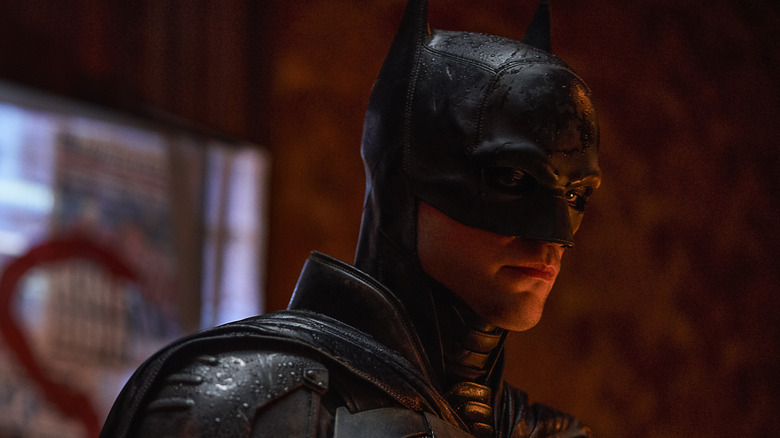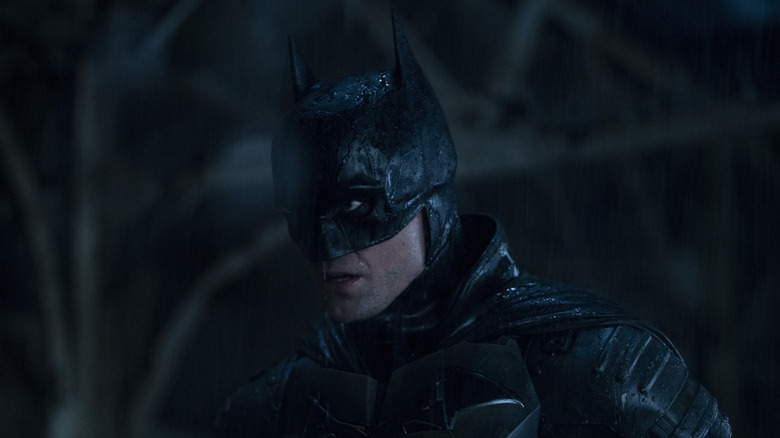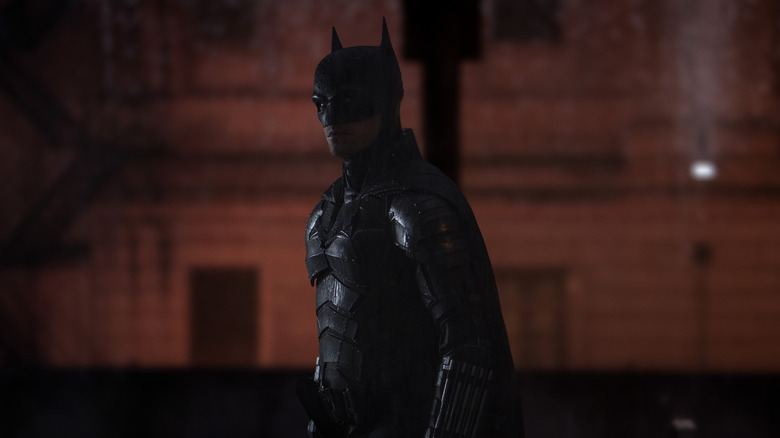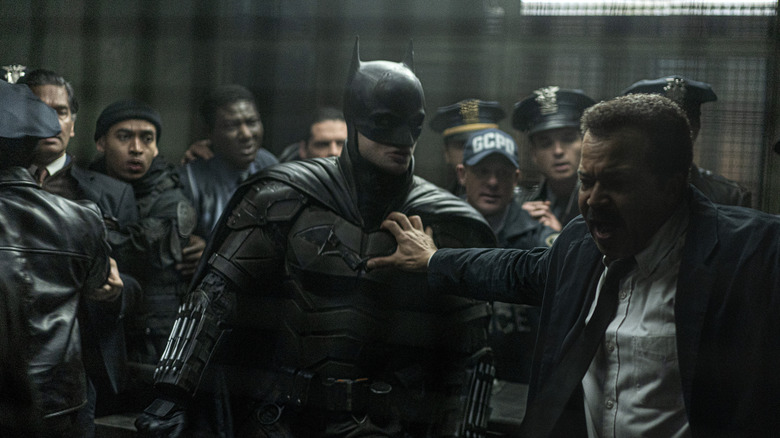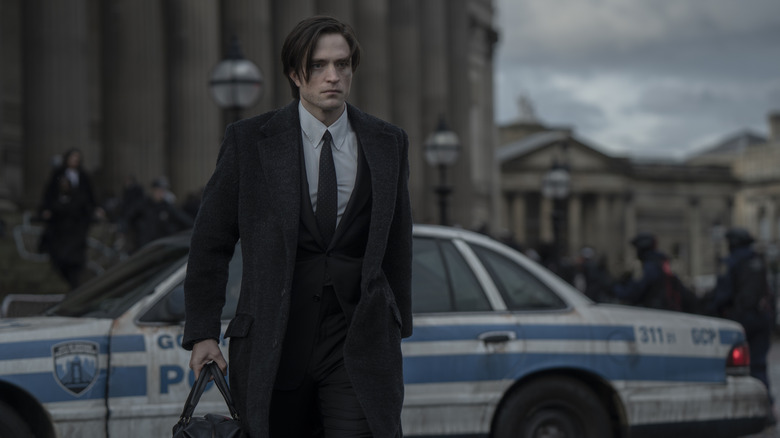The Batman Brings Back The Caped Crusader's Biggest Rule
We may receive a commission on purchases made from links.
Batman doesn't kill. That's the rule that we've heard or seen for so long in the comics, the TV series, and the films. It's one of the reasons this angry and grieving man is a hero and not a villain.
There are exceptions, of course, particularly early on in the character's history. He kills Stryker in 1939's Detective Comics #27 by pushing him into a vat of acid. He called it a "fitting end for his kind." He does it in 1940s with Batman #1 where he says, "As much as I hate to take a human life, I'm afraid this time it's necessary." These exceptions stand out because of their infrequency though, and as we see in "The Batman," the rule is back. The film is dark, and it's brutal, but Batman's rule sticks.
Yes, there are spoilers for "The Batman" here. Look into his eyes in that pic above before you decide if you want to continue. He's judging you.
Rules can keep you from going over the edge
The Robert Pattinson version of Bruce Wayne in "The Batman" is more brooding than we've seen in a while. He's clearly dealing with PTSD after the death of his parents, which we thankfully do not see this time. He's pushing Alfred (Andy Serkis), the only family he has left, away. He's beating up criminals in train stations. He's right on the edge of snapping when the film starts. It's been two years of nights, he tells us in a very Rorschach in "Watchmen" sort of voiceover. He has to record what happens because things are beginning to blur for him. This is not a man who is stable, and when you're teetering on the edge, something — a rule — has to keep you from stepping over the line.
Batman is at a boiling point. He says that he can't be everywhere, that he is a shadow, that the Bat signal is a warning to the criminals and not just a sign for him. The thing is, he can't contain the crime in Gotham. It's a disaster, and he's overwhelmed and exhausted. You can feel how badly he wants to take everyone out early on.
You really see it in the train station scene. He certainly punches the gang members hard enough to kill (and hard enough to scare the man he's trying to save), but he's not using a gun. He's using his fists and a taser. Despite getting shot repeatedly, he has this small level of control over himself. He's happy to smash the Penguin's (Colin Farrell) head into a glass window in the office for the Iceberg Lounge. He uses the Batmobile as a weapon of sorts against him in the car chase, which could have killed old Oz. He pushes people off of the light cluster at Gotham Square Garden, but even then, they're hanging by their backs on their own harnesses. He's got smoke bombs, and tons of weapons, but he will not kill.
'Remember, we never kill with weapons of any kind'
Bruce knows what guns do. He knows what he suffered at the hands of his parents' killers. He knows what the Mayor's son will live with now after seeing his own father's body. Bruce is brutal, but he knows that there has to be a line between what he does and what the killers do. He even saves Falcone (John Turturro) from Selina (Zoë Kravitz) when she pushes him off the roof, and takes the gun out of her hand when she tries to shoot. He tells her not to throw her life away, knowing how close he's come to doing the same.
In Dr. Travis Langley's book "Batman and Psychology: A Dark and Stormy Knight," (full disclosure: I was one of the proofreaders for this book), he explains that while Batman did carry a gun early on, it later became a no-no. In the comics, he sometimes finds the gun that Joe Chill used to kill his parents and keeps it or melts it down to create a metal bat symbol on his chest. He says, "So the metal that broke my heart as a child? That same metal will protect my heart as a man. And that is justice." He chooses not to use it, and that active choice makes him the hero, and keeps him from becoming like Chill.
Langley explains in his book:
"The one time that Batman fires a gun at a human being prompted editor Whit Ellsworth to summon Bat-creators [Bob] Kane and [Bill] Finger and tell them Batman must never kill, adding, 'Never let us have Batman carry a gun again.' Writer Bill Finger agreed. 'I goofed,' he said later. 'Batman shouldn't have ever had to kill people.'"
Later in Batman #4, Batman tells Robin, "Remember, we never kill with weapons of any kind!"
Death begets death
You could argue that some of Batman's actions in "The Batman" could certainly have caused deaths, that freeway chase being one of them. We humans are fragile creatures. Even a punch can kill sometimes. He's not actively trying to cause death in "The Batman," though. He's fighting his own need for revenge by not allowing other people to be so heartbroken that killing is their response. In France's Premiere magazine (via THR), Pattinson says of his version of Batman, "There is this rule with Batman: he must not kill. It can be interpreted in two ways. Either he only wants to inflict the appropriate punishment, or he wants to kill, and his self-control prevents him from doing so."
Bruce understands that once you cross that line, you can't go back. Dr. Langley argues is that one of the reasons for this is reaction formation, which means controlling an impulse by doing the opposite. He saves his enemies rather than killing them, Falcone as an example. I think of it like this; imagine an alcoholic who not only doesn't drink, but pushes away any thought of it by becoming a crusader to help other people stop.
Can one argue that the Riddler being dead would actually save lives? Sure, but the next villain to rise could look at the dead villain as a martyr. It might cause the child of a killer, the parents, the friends to become killers themselves because of the trauma the death of that villain by Batman caused. Blood feuds are a real thing. Weregild – payment for a death that then barred revenge killing — was codified in Frankish Salic Code all the way back in 500 CE to stop family blood feuds. The killing has to stop somewhere, and for Batman, it stops with him.
The hero we need
We all have our own versions of Batman. Maybe it's the one we saw first, the one that looked the coolest, the one we wish we could be. There are so many versions of the Caped Crusader, from Adam West's Bright Knight, to Christian Bale's Dark Knight, to comic book runs, animated series, LEGO ... every one of them is Batman. The version I like best though, is the one who understands how close he is to becoming that which he fights. Dr. Langley mentions an instance where Jason Todd argues with Batman about killing, saying, "What? Your moral code won't allow that? It's too hard to 'cross that line?'" Batman tells him, "No. God almighty, no. It'd be too damned easy." Hard choices make us heroes, not the easy ones.
The difference between Batman and the people he fights is often that they both want to kill, but that Batman chooses a different path. It's a path that keeps him from orphaning anyone else, making people widows or widowers, or becoming that which he rails against. With everything going on in the world right now, that's the Batman I want. It's the Batman we need, though maybe not the Batman we deserve.
